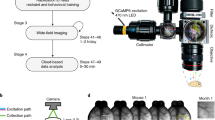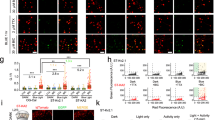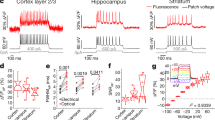Abstract
Researchers in behavioral neuroscience have long sought imaging techniques that can identify and distinguish neural ensembles that are activated by sequentially applied stimuli at single-cell resolution across the whole brain. Taking advantage of the different kinetics of immediate–early genes' mRNA and protein expression, we addressed this problem by developing tyramide-amplified immunohistochemistry–fluorescence in situ hybridization (TAI-FISH), a dual-epoch neural-activity-dependent labeling protocol. Here we describe the step-by-step procedures for TAI-FISH on brain sections from mice that were sequentially stimulated by morphine (appetitive first stimulus) and foot shock (aversive second stimulus). We exemplify our approach by FISH-labeling the neural ensembles that were activated by the second stimulus for the mRNA expression of c-fos, a well-established marker of neural activation. We labeled neuronal ensembles activated by the first stimulus using fluorescence immunohistochemistry (IHC) for the c-fos protein. To further improve the temporal separation of the c-fos mRNA and protein signals, we provide instructions on how to enhance the protein signals using tyramide signal amplification (TSA). Compared with other dual-epoch labeling techniques, TAI-FISH provides better temporal separation of the activated neural ensembles and is better suited to investigation of whole-brain responses. TAI-FISH has been used to investigate neural activation patterns in response to appetitive and aversive stimuli, and we expect it to be more broadly utilized for visualizing brain responses to other types of stimuli, such as sensory stimuli or psychiatric drugs. From first stimulation to image analysis, TAI-FISH takes ∼9 d to complete.
This is a preview of subscription content, access via your institution
Access options
Access Nature and 54 other Nature Portfolio journals
Get Nature+, our best-value online-access subscription
$29.99 / 30 days
cancel any time
Subscribe to this journal
Receive 12 print issues and online access
$259.00 per year
only $21.58 per issue
Buy this article
- Purchase on Springer Link
- Instant access to full article PDF
Prices may be subject to local taxes which are calculated during checkout





Similar content being viewed by others
References
Sheng, M. & Greenberg, M.E. The regulation and function of c-fos and other immediate early genes in the nervous system. Neuron 4, 477–485 (1990).
Lyford, G.L. et al. Arc, a growth factor and activity-regulated gene, encodes a novel cytoskeleton-associated protein that is enriched in neuronal dendrites. Neuron 14, 433–445 (1995).
Cole, A.J., Saffen, D.W., Baraban, J.M. & Worley, P.F. Rapid increase of an immediate early gene messenger RNA in hippocampal neurons by synaptic NMDA receptor activation. Nature 340, 474–476 (1989).
Morgan, J.I., Cohen, D.R., Hempstead, J.L. & Curran, T. Mapping patterns of c-fos expression in the central nervous system after seizure. Science 237, 192–197 (1987).
Xiu, J. et al. Visualizing an emotional valence map in the limbic forebrain by TAI-FISH. Nat. Neurosci. 17, 1552–1559 (2014).
Namburi, P. et al. A circuit mechanism for differentiating positive and negative associations. Nature 520, 675–678 (2015).
Beyeler, A. et al. ivergent routing of positive and negative information from the amygdala during memory retrieval. Neuron 90, 348–361 (2016).
Kim, J., Pignatelli, M., Xu, S., Itohara, S. & Tonegawa, S. Antagonistic negative and positive neurons of the basolateral amygdala. Nat. Neurosci. 19, 1636–1646 (2016).
Lammel, S. et al. Input-specific control of reward and aversion in the ventral tegmental area. Nature 491, 212–217 (2012).
Ye, L. et al. Wiring and molecular features of prefrontal ensembles representing distinct experiences. Cell 165, 1776–1788 (2016).
Johnson, Z.V., Revis, A.A., Burdick, M.A. & Rhodes, J.S. A similar pattern of neuronal Fos activation in 10 brain regions following exposure to reward- or aversion-associated contextual cues in mice. Physiol. Behav. 99, 412–418 (2010).
Gore, F. et al. Neural representations of unconditioned stimuli in basolateral amygdala mediate innate and learned responses. Cell 162, 134–145 (2015).
Sakurai, K. et al. Capturing and manipulating activated neuronal ensembles with CANE delineates a hypothalamic social-fear circuit. Neuron 92, 739–753 (2016).
Guzowski, J.F., McNaughton, B.L., Barnes, C.A. & Worley, P.F. Environment-specific expression of the immediate-early gene Arc in hippocampal neuronal ensembles. Nat. Neurosci. 2, 1120–1124 (1999).
Guzowski, J.F., McNaughton, B.L., Barnes, C.A. & Worley, P.F. Imaging neural activity with temporal and cellular resolution using FISH. Curr. Opin. Neurobiol. 11, 579–584 (2001).
Lin, D. et al. Functional identification of an aggression locus in the mouse hypothalamus. Nature 470, 221–226 (2011).
Chaudhuri, A., Nissanov, J., Larocque, S. & Rioux, L. Dual activity maps in primate visual cortex produced by different temporal patterns of zif268 mRNA and protein expression. Proc. Natl. Acad. Sci. USA 94, 2671–2675 (1997).
Worley, P.F. et al. Constitutive expression of zif268 in neocortex is regulated by synaptic activity. Proc. Natl. Acad. Sci. USA 88, 5106–5110 (1991).
Kaminska, B., Kaczmarek, L. & Chaudhuri, A. Visual stimulation regulates the expression of transcription factors and modulates the composition of AP-1 in visual cortex. J. Neurosci. 16, 3968–3978 (1996).
Bobrow, M.N., Shaughnessy, K.J. & Litt, G.J. Catalyzed reporter deposition, a novel method of signal amplification. II. Application to membrane immunoassays. J. Immunol. Methods 137, 103–112 (1991).
Bobrow, M.N., Harris, T.D., Shaughnessy, K.J. & Litt, G.J. Catalyzed reporter deposition, a novel method of signal amplification. Application to immunoassays. J. Immunol. Methods 125, 279–285 (1989).
Vazdarjanova, A., McNaughton, B.L., Barnes, C.A., Worley, P.F. & Guzowski, J.F. Experience-dependent coincident expression of the effector immediate-early genes arc and Homer 1a in hippocampal and neocortical neuronal networks. J. Neurosci. 22, 10067–10071 (2002).
Bammer, G. Pharmacological investigations of neurotransmitter involvement in passive avoidance responding: a review and some new results. Neurosci. Biobehav. Rev. 6, 247–296 (1982).
Bechara, A. & van der Kooy, D. Opposite motivational effects of endogenous opioids in brain and periphery. Nature 314, 533–534 (1985).
Zangenehpour, S. & Chaudhuri, A. Neural activity profiles of the neocortex and superior colliculus after bimodal sensory stimulation. Cereb. Cortex 11, 924–935 (2001).
Reijmers, L.G., Perkins, B.L., Matsuo, N. & Mayford, M. Localization of a stable neural correlate of associative memory. Science 317, 1230–1233 (2007).
Guenthner, C.J., Miyamichi, K., Yang, H.H., Heller, H.C. & Luo, L. Permanent genetic access to transiently active neurons via TRAP: targeted recombination in active populations. Neuron 78, 773–784 (2013).
Xue, Y.X. et al. Selective inhibition of amygdala neuronal ensembles encoding nicotine-associated memories inhibits nicotine preference andrelapse. Biol. Psychiatry 82, 781–793 (2017).
Luppi, P.H., Sakai, K., Fort, P., Salvert, D. & Jouvet, M. The nuclei of origin of monoaminergic, peptidergic, and cholinergic afferents to the cat nucleus reticularis magnocellularis: a double-labeling study with cholera toxin as a retrograde tracer. J. Compar. Neurol. 277, 1–20 (1988).
Soudais, C., Skander, N. & Kremer, E.J. Long-term in vivo transduction of neurons throughout the rat CNS using novel helper-dependent CAV-2 vectors. FASEB J. 18, 391–393 (2004).
Norgren, R.B. Jr. & Lehman, M.N. Herpes simplex virus as a transneuronal tracer. Neurosci. Biobehav. Rev. 22, 695–708 (1998).
Wickersham, I.R., Finke, S., Conzelmann, K.K. & Callaway, E.M. Retrograde neuronal tracing with a deletion-mutant rabies virus. Nat. Methods 4, 47–49 (2007).
Tervo, D.G. et al. A designer AAV variant permits efficient retrograde access to projection neurons. Neuron 92, 372–382 (2016).
Cetin, A. & Callaway, E.M. Optical control of retrogradely infected neurons using drug-regulated 'TLoop' lentiviral vectors. J. Neurophysiol. 111, 2150–2159 (2014).
Root, C.M., Denny, C.A., Hen, R. & Axel, R. The participation of cortical amygdala in innate, odour-driven behaviour. Nature 515, 269–273 (2014).
Kawashima, T. et al. Functional labeling of neurons and their projections using the synthetic activity-dependent promoter E-SARE. Nat. Methods 10, 889–895 (2013).
Liu, X. et al. Optogenetic stimulation of a hippocampal engram activates fear memory recall. Nature 484, 381–385 (2012).
Ramirez, S. et al. Creating a false memory in the hippocampus. Science 341, 387–391 (2013).
Sorensen, A.T. et al. A robust activity marking system for exploring active neuronal ensembles. eLife 5, e13918 (2016).
Lee, D., Hyun, J.H., Jung, K., Hannan, P. & Kwon, H.B. A calcium- and light-gated switch to induce gene expression in activated neurons. Nat. Biotechnol. 35, 858–863 (2017).
Wang, W. et al. A light- and calcium-gated transcription factor for imaging and manipulating activated neurons. Nat. Biotechnol. 35, 864–871 (2017).
Gage, G.J., Kipke, D.R. & Shain, W. Whole animal perfusion fixation for rodents. J. Vis. Exp. 65, e3564 (2012).
Ezaki, T., Hashimoto, Y. & Yabuuchi, E. Fluorometric deoxyribonucleic acid-deoxyribonucleic acid hybridization in microdilution wells as an alternative to membrane filter hybridization in which radioisotopes are used to determine genetic relatedness among bacterial strains. Int. J. Syst. Evol. Microbiol. 39, 224–229 (1989).
Acknowledgements
We thank the Hu laboratory members for valuable discussions and advice. This study was supported by grants from the Ministry of Science and Technology of China (2011CBA00400, 2016YFA0501000), the National Natural Science Foundation of China (91432108, 31225010, and 81527901) and the Strategic Priority Research Program (B) of the Chinese Academy of Sciences (XDB02030004) to H.H., and by a grant from the National Natural Science Foundation of China (81571335) to Q.H.
Author information
Authors and Affiliations
Contributions
Q.Z. and H.H. designed the experimental strategy. Q.Z., J.W. and C.F. optimized experimental procedures. Q.H., Q.Z. and C.F. wrote the manuscript with input from all authors.
Corresponding author
Ethics declarations
Competing interests
The authors declare no competing financial interests.
Rights and permissions
About this article
Cite this article
Zhang, Q., He, Q., Wang, J. et al. Use of TAI-FISH to visualize neural ensembles activated by multiple stimuli. Nat Protoc 13, 118–133 (2018). https://doi.org/10.1038/nprot.2017.134
Published:
Issue Date:
DOI: https://doi.org/10.1038/nprot.2017.134
This article is cited by
-
Dorsal CA3 overactivation mediates witnessing stress-induced recognition memory deficits in adolescent male mice
Neuropsychopharmacology (2024)
-
GluN2A mediates ketamine-induced rapid antidepressant-like responses
Nature Neuroscience (2023)
-
Illuminating the Activated Brain: Emerging Activity-Dependent Tools to Capture and Control Functional Neural Circuits
Neuroscience Bulletin (2019)
Comments
By submitting a comment you agree to abide by our Terms and Community Guidelines. If you find something abusive or that does not comply with our terms or guidelines please flag it as inappropriate.



